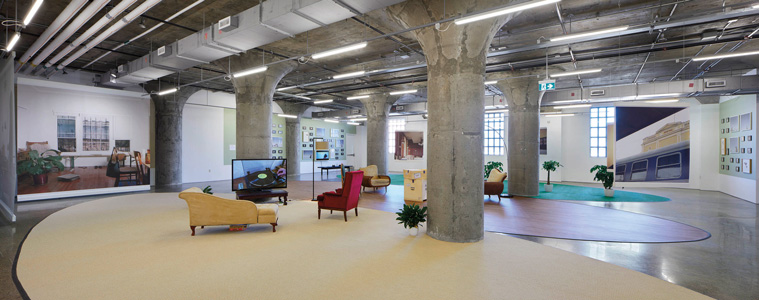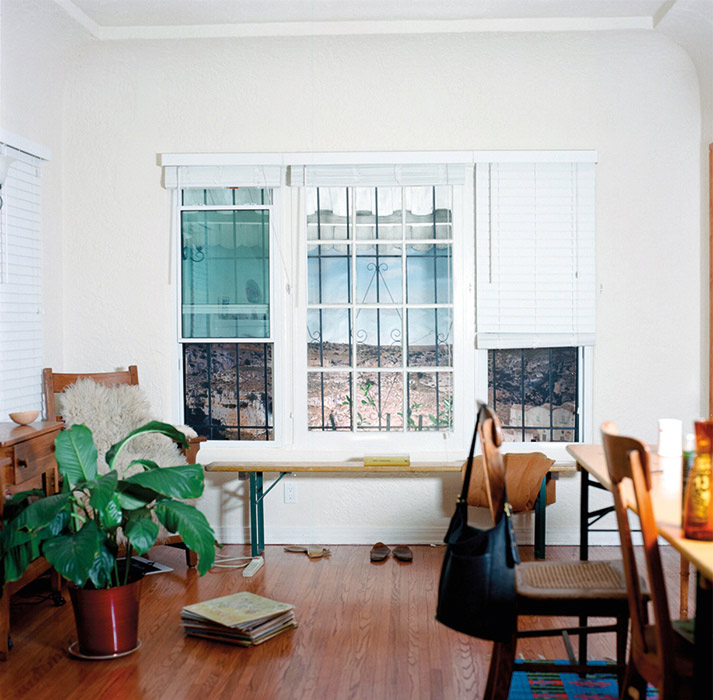[Summer 2019]
Museum of Contemporary Art, Toronto
February 14–April 14, 2019
By Jill Glessing
Basma Alsharif asks a question for our time. Increasing human migration prompted by wars and climate change means, for many, an experience of cultural displacement. Born in Kuwait to Palestinian refugee parents who had fled Israeli occupation, Alsharif migrated first to France then to the United States. Her continuing nomadic existence informs her art production. As a person of diaspora, struggling with questions of identity and alienated from the seemingly endless Palestinian struggle, she asks, If oppressive power relations – such as those between states, ethnicities and genders – can’t be eliminated, how else might we claim our freedom? In her exhibition at the Museum of Contemporary Art, Alsharif pursues these themes through intricate but playful combinations of photography, video, film, and text. Reflecting the artist’s discomfort with borders, her themes and materials mingle and overlap through four installations on MOCAs expansive third floor.
One favoured approach is the exploration of autofiction – imaginative narratives in which fictional characters entwine with the artist’s own biography – to incubate new identities unfettered by official histories. In a video titled The Story of Milk and Honey (2011) – the centrepiece of the eponymous installation – a male voice describes his intention while in Lebanon to write a love story devoid of political tensions. On surrounding walls hang different genres of images: small black-and-white framed family photos with faces erased; numerous large colour photographs shot by Alsharif capturing fragments of unidentified strollers along the Corniche in Beirut; pages of botanical drawings and texts from a book on native plants explaining the conditions necessary for
species survival, suggesting the question for transplanted refugees – can cultural identities survive outside their native habitat? – and Alsharif’s own partially completed drawings of botanical specimens. As the video concludes, the narrator, whose identity gradually merges with the artist’s, admits his failure to write his desired story. Coupled with the refugee’s longing for emotional and cultural completion is a persistent sense of impossibility and lack.
The installation Trompe l’Oeil (2016) stages multiple layers that, like skins of reality, are revealed through careful attention. Alsharif’s California home is represented in two wall-size photographic murals forming a corner in the gallery, each wall showing a different view of her living room; the same room is also reconstructed in the gallery with furniture and plants. A television monitor on a coffee table screens short, jagged clips of the artist performing domestic activities – making tea, sitting on a toilet, embracing her lover – in the rooms presented in the mural.
We look to our homes to provide safety and comfort, but this home is haunted by suggestions of dislocation and trauma: the video’s jarring soundtrack mixes discordant samples from a recording of cinematic sound effects, synching foreign soundbites to the artist’s private and intimate movements; even inside the photographed interior, additional layers of reality appear: a red curtain covering a doorway is not made of fabric but is a photograph of a curtain that would obstruct passage; replacing her actual California window view is a photographic scene of Matera, Italy, the location chosen by Pier Paolo Pasolini for his film The Gospel According to Saint Matthew (1964), after rejecting the more authentic sites scouted in Palestine. Three prints of archival photographs of Arab slaves taken by Arabist T. E. Lawrence are stuck to the wall. In pointed resistance to official colonial history, a wall text notes that these images are copyright protected and presented here without permission. Alongside the constructed living room, a cluster of thirty-eight small framed prints of archival images from London’s British Museum depict colonial encounters with indigenous peoples, their salon-style display presenting a disturbed family tree. For the colonized and diasporic, reality is uncertain, broken, haunted.
It may be Alsharif’s sensitivity to chafing geopolitical borders that prompts her resistance to restrictions in her own practice, as she explores and slips seamlessly between and across expressive forms. At the centre of A Philistine (2018) is a novella that she has written. Chairs surrounding a wooden packing crate on which are placed multiple copies of the book inviting visitors to sit and read. The story, printed in both English and Palestinian Arabic, begins with an erotic love affair and then follows its main character across geography and history – France, Cairo, pre-apartheid Gaza, pharaonic Egypt – to arrive finally at a state of ecstatic transcendence, the dissolution of all distinctions and hierarchies – the milk and honey of Biblical provenance. But, hanging throughout the gallery and permeating other installations are large photographic banners depicting train station interiors shot by Alsharif during her travels through Serbia, Bosnia, and Croatia – another region of contested borders. They remind us of perpetual tension – the push and pull between our desire for freedom and the conditions that constrain us – and our struggle to find a place to settle.
Jill Glessing teaches at Ryerson University and writes on visual arts and culture.
[ Complete issue, in print and digital version, available here: Ciel variable 112 – COLLECTIONS REVISITED ]
[ Individual article in digital version available here: Basma Alsharif — Jill Glessing ]


